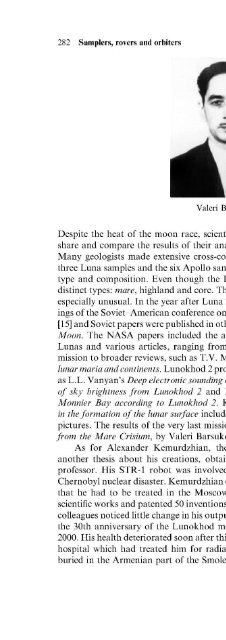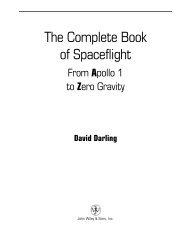- Page 2:
Soviet and Russian Lunar Exploratio
- Page 6:
Brian Harvey 2 Rathdown Crescent Te
- Page 10:
3 Planning the lunar landing 45 Vos
- Page 14:
8 Return to the moon 287 After N-l:
- Page 18:
Prologue Siberia, summer of 1976. N
- Page 22:
Although the United States Apollo p
- Page 26:
The 8K78 71 The Ye-6 lander 73 Dish
- Page 30:
Lunokhod returns to landing stage 2
- Page 34:
Abbreviations and acronyms AIS Auto
- Page 38:
1 Origins of the Soviet lunar progr
- Page 42:
Sergei Korolev, Mstislav Keldysh Wi
- Page 46:
Introducing the father of the Sovie
- Page 50:
On rocket research into the upper l
- Page 54:
pad for the returning spacecraft. H
- Page 58:
The R-7 called a 'packet' design -
- Page 62:
• An academy of sciences, to prov
- Page 66:
Sputnik
- Page 70:
spacecraft be sent to the moon. One
- Page 74:
They were hypergolic and fired on c
- Page 78:
Early tracking dish, Crimea ONLY HO
- Page 82:
and carefully sifted for clues. Wha
- Page 86:
First Cosmic Ship arose from a 1956
- Page 90:
First Cosmic Ship, top stage Gringa
- Page 94:
In Britain, the director of the lar
- Page 98:
gammas, where a response was consid
- Page 102:
Sergei Vernov But 8,000 km out from
- Page 106:
in Leningrad in 1955. The first tra
- Page 110:
The station swung around the south
- Page 114:
Automatic Interplanetary Station ar
- Page 118:
Instruments of the Automatic Interp
- Page 122:
3 Planning the lunar landing After
- Page 126:
shaped acorn-like cabin. Tikhonravo
- Page 130:
9 S 7 6 5 Soyuz complex - second bl
- Page 134:
aspect of the plan. Alexander Sharg
- Page 138:
Joint flight to the moon proposed b
- Page 142:
were disputed by some Soviet scient
- Page 146:
of a government diktat from on high
- Page 150:
delayed, had a difficult design his
- Page 154:
the moon. The 50 tonnes were gradua
- Page 158:
have a thrust of 5,760 tonnes, able
- Page 162:
tried to mediate between Sergei Kor
- Page 166:
Key government and party decisions
- Page 170:
Ye-1 to -4 series, which was provin
- Page 174:
The new 8K78 rocket, including bloc
- Page 178:
Landing cabin Height 112 cm Base 58
- Page 182:
Dishes at Yevpatoria
- Page 186:
Once again, the block L let everyon
- Page 190:
Georgi Babakin health. He returned
- Page 194:
Luna mid-course correction Luna 6 o
- Page 198:
Zond 3 over Mare Orientale lines. T
- Page 202:
Zond 3: scientific instruments Two
- Page 206:
Cosmonaut Alexei Leonov described h
- Page 210:
Luna 9 camera system They were not.
- Page 214:
In minutes, the world had seen the
- Page 218:
Luna 13 images meter which found th
- Page 222:
Ye-6, -6M: scientific outcomes Luna
- Page 226:
design bureau in Dnepropetrovsk. It
- Page 230:
Luna 10 cabin The discoveries of Lu
- Page 234:
Luna 11, 12 design presumably this
- Page 238:
MiKCVTO? Ye-6LF (originally Ye-7) H
- Page 242:
Luna 10 and mother ship Summary of
- Page 246:
Ye-6S, Ye-6LF, Ye-6LS series: scien
- Page 250:
5 The first cosmonauts to the moon
- Page 254:
RD-253 with zirconium. OKB-456 deve
- Page 258:
Russia's UR-500K Proton Length 44.3
- Page 262:
The slogan of the GIRD group, writt
- Page 266:
Two months later, on 24th September
- Page 270:
Spurring people on - Korolev in 196
- Page 274:
Americans took a different view). K
- Page 280:
Engines Thrust (each) Total thrust
- Page 284:
to launch a very big space station.
- Page 288:
The Soyuz spacecraft The initial te
- Page 292:
Soyuz spacecraft rendezvous, dockin
- Page 296:
From August 1964, the Soviet lunar
- Page 300:
The Soviet around-the-moon mission
- Page 304:
Cosmos 146 was the fifth flight of
- Page 308:
Rendezvous in Earth orbit
- Page 312:
housed here, and it was from this m
- Page 316:
• One 11D411 RD-858 main engine w
- Page 320:
LK ladder
- Page 324:
The return-to-Earth profile was qui
- Page 328:
Cosmonaut on the lunar surface Unli
- Page 332:
during takeoff and rendezvous shoul
- Page 336:
Tracking ship Cosmonaut Yuri Gagari
- Page 340:
Early Soviet cosmonauts, Sochi, 196
- Page 344:
Yuri Gagarin at home entry is now m
- Page 348:
Yuri Gagarin with Valentina Tereshk
- Page 352:
Cosmonaut Valentin Yershov, lunar n
- Page 356:
Although a member of the original g
- Page 360:
The moon teams: Moon Team 1: Alexei
- Page 364:
this group. These cosmonauts did ve
- Page 368:
Soyuz trainer thrown against a mock
- Page 372:
Alexei Leonov's spacewalk over foot
- Page 376:
Alexei Leonov splashdown-training i
- Page 380:
Valeri Bykovsky parachuting return
- Page 384:
Pavel Popovich 1975, setting a Sovi
- Page 388:
The opportunity to use the Soviet i
- Page 392:
[17] Mills, Phil: Aspects of the So
- Page 396:
L-1 ZOND 5 Autumn was well in the a
- Page 400:
man been aboard all along and would
- Page 404:
A successful flight of Soyuz would
- Page 408:
later began its second reentry. At
- Page 412:
the cosmonaut squad, General Kamani
- Page 416:
Leaving Earth, now 70,000 km distan
- Page 420:
atmosphere. After a little while, t
- Page 424:
Dmitri Okhotsimsky had calculated t
- Page 428:
Yevgeni Khrunov, Alexei Yeliseyev p
- Page 432:
The spectacle of the two docked cra
- Page 436:
Mstislav Keldysh announces space st
- Page 440:
N-1 on the pad
- Page 444:
consideration even given for a mann
- Page 448:
The Ye-8-5 Luna 15 was the first of
- Page 452:
The Ye-8-5 return cabin At 10: 00 o
- Page 456:
precise moment for retrofire as car
- Page 460:
A full Earth for Zond 7 invidious c
- Page 464:
the southern hemisphere and make a
- Page 468:
assured the world there was no need
- Page 472:
CANCELLATION OF THE MOON-LANDING PR
- Page 476:
Alexei Isayev to 7.5 hours and a fi
- Page 480:
• Better thermal protection for t
- Page 484:
Lavochkin. A date was even set for
- Page 488:
sent to lecture at the Moscow Aviat
- Page 492:
programme encountered ever more dif
- Page 496:
[26]. Of this, the N-1 accounted fo
- Page 500:
Americans may have had profound pol
- Page 504:
7 Samplers, rovers and orbiters Whe
- Page 508:
Luna 16, testing before launch for
- Page 512:
terminated and the sample collected
- Page 516:
The Luna 16 cabin back on Earth It
- Page 520:
DESIGNING A LUNAR ROVER Although th
- Page 524:
correct, being confirmed by Luna 13
- Page 528:
Luna 17 descent stage Lunokhod carr
- Page 532:
Lunokhod descending to the moon Not
- Page 536:
eceiving dishes. Five controllers s
- Page 540: Lunokhod tracks that would collect
- Page 544: Lunokhod porthole view ber, Lunokho
- Page 548: much weaker than the lunar roving v
- Page 552: The intentions behind Luna 18 becam
- Page 556: Luna 20 landed in snow
- Page 560: Lunokhod 2 with hills behind Union!
- Page 564: analyses at numerous spots. In the
- Page 568: lunar programme, the real story did
- Page 572: first day of operation, indicating
- Page 576: Luna 22 6 June 1974 (LOI) 219 x 221
- Page 580: Luna 15, 23, 24 landing sites befor
- Page 584: Location of Soviet moon probes WIND
- Page 588: Lunokhod 3 When Lunokhod 3 was canc
- Page 594: ACHIEVEMENTS OF THE SOVIET AUTOMATI
- Page 598: [11] Surkov, Yuri: Exploration of t
- Page 602: of no fewer than 450 sec. A lunar e
- Page 606: cosmonaut at a time. As was the cas
- Page 610: none progressed beyond the aspirati
- Page 614: engineering and scientific sense, a
- Page 618: [8] Rebrov, Colonel M.: But this is
- Page 622: 298 List of all Soviet moon probes
- Page 626: 300 List of all Soviet moon probes
- Page 630: (1988-2003); Gordon Hooper (1990),
- Page 634: Gorin, Peter A.: Rising from the cr
- Page 638: Pesavento, Peter: Soviet space prog
- Page 642:
Wright, Pearce: Vasili Mishin - spa
- Page 646:
Bogomolov, Alexei 221 Boguslavsky,
- Page 650:
Kennedy, John F. Moon speech, 52 Pr
- Page 654:
Printing: Mercedes-Druck, Berlin Bi
- Page 658:
Tikhonravov, Mikhail (cont.) Propos







